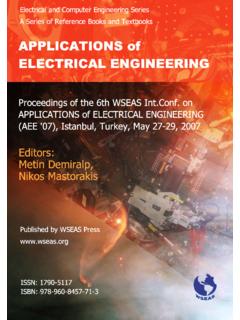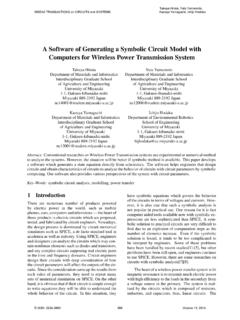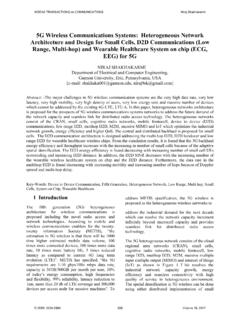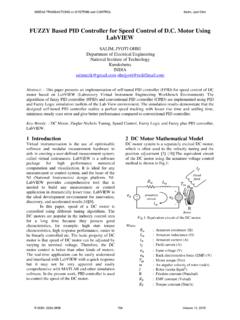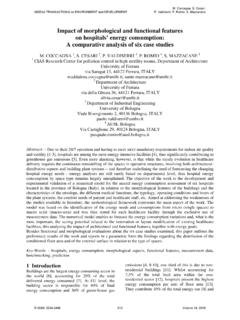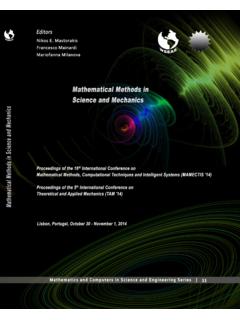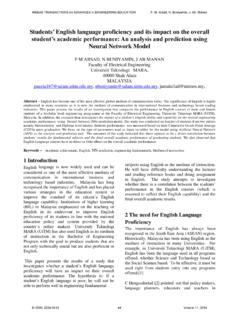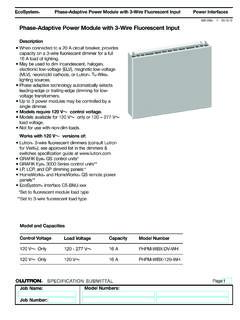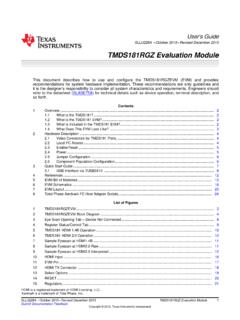Transcription of Development of Hybrid Maximum Power Point Tracking …
1 Development of Hybrid Maximum Power Point Tracking control algorithm for photovoltaic system Ayaz Ahmad, Research Scholar, Singhania University, Pacheri Bari, India and L. Rajaji, Principal, ARM College of Engineering & Technology, Chennai Abstract: Renewable energy now-a-days is playing vital role in energy demand market and solar and wind are most wanted renewable energy resources to support the enormous Power demand across the globe. Due to insufficient wind for more than half of the year, wind turbines are not capable of meeting the Power demand. Hence, solar is treated as the main energy resource among all the renewable energy resources since sunlight is available almost all the days even though it is only available in day time. Solar system or photovoltaic (PV) system is capturing sunlight and converts it into electricity either for off-grid or in-grid applications.
2 Amount of generation of electricity is purely depending upon the amount of sunlight captured by the PV panels and hence Tracking of sunlight in order to capture Maximum Power is the main requirement in solar energy sector. In this paper, a novel Hybrid Maximum Power Point Tracking (MPPT) algorithm is presented and it has the combination of the features of perturb & observe algorithm and constant voltage algorithm . Proposed Hybrid MPPT algorithm is applied to single phase residential and commercial solar inverters and the results have been captured. Both simulation and experimental results have been presented in this paper in order to validate the proposed algorithm . Key words: PV panel, MPPT algorithm , Tracking efficiency, Solar system and DCDC converter. 1. Introduction Renewable energy is the inevitable requirement in recent years to overcome the Power shortage across the world.
3 Since renewable energy resources are green, clean and possibility pollution free Power production, demand for renewable energy market is booming up. However, photovoltaic systems are becoming very popular when compare to other renewable energy systems due to advanced technologies, simple constructions of PV panels and ease maintenance [1]. Hence, solar Power panels are being installed almost in all the countries and Power generation is also being improved and occupied considerable rate of energy market. Efficiency of photovoltaic system is mainly depending on the sunlight capturing capability and hence solar panels are facing the sunlight in order to capture the sun rays in perpendicular so that reflection of sunlight from the panel will be decreased and absorption will be increased.
4 Secondly, it is very important that to capture the electrical Power from the PV panel to Power converter without any losses. Since, PV panels are having non linear characteristics, Maximum Power output from the panel cannot be assured and hence Maximum Power Point Tracking (MPPT) algorithm is required to capture the Maximum Power from the panel. MPPT algorithm will track and indentify the voltage and/or current at which Maximum Power can be extracted from the PV panel. Figure 1 shows the Voltage & Power characteristics of a typical PV module. 0501001502002503003500200400600800100012 00140016001800 Voltage (V) Power (W)Voltage Vs Power Pmax Figure 1 P-V characteristics of a practical PV module Many MPPT control algorithms have been proposed to track the Maximum Power Point (MPP) and the most commonly used MPP Tracking algorithms are Perturb and Observe (P&O), Incremental Conductance (IC) and Constant Voltage (CV).
5 These algorithms have their own merits and limitations at different operating range. Jung-Min et al., [1] described Power hysteresis based Tracking for MPPT algorithm for DCDC converter. They WSEAS TRANSACTIONS on SYSTEMS and CONTROLAyaz Ahmad, L. RajajiE-ISSN: 2224-28567 Volume 10, 2015have also proposed this MPPT for three level DCDC Power converter to reduce the reverse recovery losses of the diodes during boost operation. With a view to minimize the overall cost and control complexity, a novel MPPT algorithm presented in [2] in order to operate in continuous conduction mode of boost converter. This algorithm was presented by the authors in order to reduce the stress on the Power components. Similarly, in [3-6], Maximum Power Point Tracking phenomenon with different approaches such as perturb and observe, constant voltage algorithms presented by respective authors.
6 One of the effective algorithms is Incremental-conductance algorithm (IC) which is widely employed due to easy implementation and high Tracking accuracy. In [7] and [8], variable step-size IC MPPT algorithm is presented, it has not only the merits of IC but also automatically adjusts the step size to track the PV array MPP as proposed by authors. Single stage and double stage photovoltaic systems are presented in [9] and [10] respectively in which perturb and observe algorithm was proposed. In [11-14], adaptive MPPT algorithms for photovoltaic system are presented which is suitable for unstable sunlight with more non-linear conditions to capture Maximum possible Power . FPGA-based Fuzzy MPPT control algorithm is proposed in [15] and authors mentioned that this method is simple, reliable, and can automatically adjust with the changes of external environment.
7 Its fast optimization capability makes the system stable at the Maximum Power Point . MPPT algorithms are analyzed for this research in detail not only for solar energy systems and also for other applications such as aerospace [16] and wind energy system [17]. In [16], perturb and observe algorithm has been proposed for aerospace and electronic application and in [17] a novel Maximum Power Point Tracking controller with an adaptive compensation control is first proposed for a micro scale wind Power generation system . A short introduction on the general Development and forecast of world market in photovoltaic (PV) are presented in [18]. To overcome inherent limitations of these algorithms in solar Power converters, a Hybrid algorithm based on combination of Perturb and Observe (P&O) algorithm and Constant Voltage (CV) algorithm is presented in this paper.
8 In this proposed approach, the system selects either P&O or CV algorithm based on the light intensity which is measured as a function of current. 2. PV Panel Modeling photovoltaic (PV) panels are facing Sun and capturing sunlight with adjustable inclination and give the electrical output either to a battery or to an energy storage device. PV panels are comprised of PV cell arrays in a matrix form and cumulative voltage output is observed across the output terminals. Figure 2 shows the equivalent circuit of PV panel which represents a current source with a diode. I-V characteristics curve of PV cell shown in Figure 2 is developed from the equation (1). In an ideal cell, the total current Ipv is equal to the current Isun generated by the photoelectric effect minus the diode current Irs , according to the equation: =1expTambkAqUIrsIsunIpv --- (1) But in the practical case the current generated by the PV cell is given by, RpRsIpvUAURsIpvUIrsIsunIpvt + + =1exp --- (2) Where, U - PV cell output voltage.
9 Ipv - PV cell output current. Isun - photocurrent, function of irradiation level and junction temperature. Irs - Reverse saturation current of diode. q - Charge of an electron ( 10-19 ) k - Boltzmann constant ( 10-23 J/K). Tamb - cell operating temperature. A Ideality Factor Rs - Series resistance. Rp - Shunt resistance. Ut Junction Thermal Voltage given by qTambkNsUt = Ns Number of Cells connected in series. Ns Number of Cells connected in series. The current generated by the photovoltaic cell is given by ()GsunSTCGsunTambSTCT ambkIscIsuntemp +=)( --- (3) Where, Isc Short circuit current. Ktemp Temperature coefficient of the cell. WSEAS TRANSACTIONS on SYSTEMS and CONTROLAyaz Ahmad, L. RajajiE-ISSN: 2224-28568 Volume 10, 2015 Tamb - Ambient Temperature. TambSTC - Ambient Temperature at standard test condition. Gsun Sun Light Intensity (W/m2) GsunSTC Sun Light Intensity at standard test condition (1000 W/m2).
10 IsunIrs Figure 2. Electrical circuit of PV panel 3. Proposed MPPT algorithm MPP Tracking is based on a combination of two methods P&O and CV based on the PV panel current. For PV current higher than 800mA, Perturb & Observe method is selected and for PV current higher lower than 700mA Constant Voltage method is selected. A hysteresis of 100mA is used when switching from one method to the other, in order to avoid frequent transitions. Figure 4 Hybrid MPPT - Combined PO & CV is explained. Constant VoltagePerturb & ObserveIpv>700mAIpv<800mA Figure 3 Hybrid MPPT algorithm selection PO or CV In Constant Voltage (CV), the open-circuit voltage is sampled every 10 seconds. This is done by disabling the PWM signals (Duty = 0), waiting for 26ms in order to have stable signals and then measuring the input voltage, which actually represent the open-circuit value (no load voltage).
